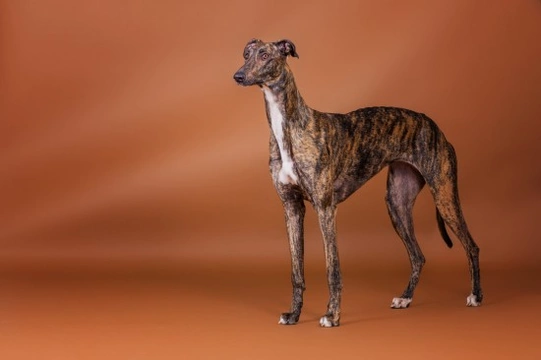
Is a greyhound the right pet for you?
The greyhound is well known as a racing dog and sighthound, which before they made their debut onto the dog tracks, were historically used for coursing game. They are one of the fastest land animals in the world when running flat out, with the fastest rate of acceleration of any animal aside from the cheetah. However, the greyhound is designed for short sprints rather than endurance, and other than their short stretches of top speed running, tend to be fairly lazy dogs as a whole!
They are intelligent and very gentle dogs, although they do have an incredibly well-honed prey drive, and they are tall, slender and deep-chested. While the greyhound is still a common sight within the UK and is one of the most common dogs to see out and about on walks, the number of pedigree greyhounds registered with The Kennel Club each year is actually rather low. Today, it is much more common to see adult ex-racing greyhounds offered up for adoption as pets than it is to find purebred registered greyhound puppies for sale, and a great number of dog shelters and greyhound adoption organisations operate within the UK, with the aim of rehoming ex-racing greyhounds.
If you are wondering if a greyhound is the right pet for you, whether you are looking for a puppy or might consider adopting an adult dog, in this article we will look at the temperament and core traits of the greyhound in more detail. Read on to learn more.
What is the temperament of the greyhound?
The greyhound is a very gentle, affectionate dog that very much loves the company of people, and is very loving with their families as well as usually being calm and personable with strangers. Greyhounds may be a little shy with newcomers when they first meet them, but they are unlikely to be aggressive.
They like their home comforts and very much enjoy cuddling up on the sofa or in front of a warm fire with their favourite people, and are sometimes reluctant to go outside when the weather is bad! They are soulful, sensitive dogs that thrive within a family environment, and are very rewarding dogs to own.
How much exercise do they require?
A common misconception among people who are not familiar with greyhounds is that they require long and strenuous periods of exercise each day, but this is not the case. The greyhound does most definitely need to be walked two or three times per day and have access to a safe, enclosed area where they can run about when on their walks, but they expend their energy in short bursts, and otherwise, tend to be fairly sedentary dogs.
Are they easy to train?
Greyhounds require calm, gentle and encouraging positive reinforcement training, and one of the most important aspects of this is training the dog for good recall when off the lead. This can be difficult to achieve if the dog is in pursuit of prey, and is something that must be carefully managed.
Greyhounds are perfectly capable of learning all of the core commands required of the well trained dog, and they work very hard to earn praise, and particularly, tasty treats!
Do they have a strong prey drive?
All greyhounds have a very pronounced prey drive, and this is particularly true of ex-racing greyhounds, which will have been trained from an early age to pursue the “rabbit” at the tracks. This means that they must be kept on a lead at all times when walking in public, and should only be allowed off the lead to run in enclosed areas. Muzzling when off the lead may also be necessary to protect wildlife.
Are they good with other dogs?
The greyhound is a very good natured and sociable dog that loves to have company, be that human or canine! They generally live perfectly happily with another dog or dogs, and often bond strongly with the other dogs in the family and appreciate having them around.
They are also generally well-mannered and good natured with strange dogs that they meet when out and about, assuming of course that they are properly socialised and taught to play nicely with others.
What sort of homes do they need?
The greyhound is a very versatile pet that fits in well to all sorts of different homes, and despite their height, they do not need an enormous home in order to thrive. They get on well with both other dogs and people, and are calm, kind and loving with children, often spending a lot of time with children that like their company.
It is important to take pains to ensure that the greyhound does not pose a threat to other suburban pets such as cats, and as such, a well-fenced garden and extra care must be taken to manage the dog’s prey drive. Over all, the greyhound is an excellent choice of pet for people of all ages, and from all walks of life.



